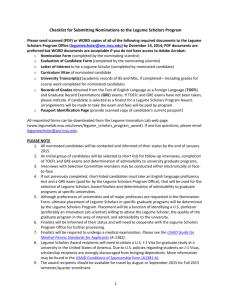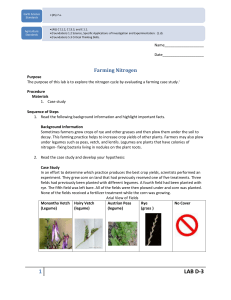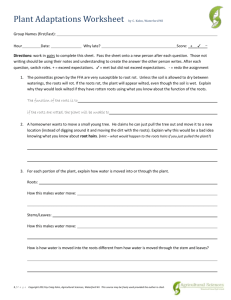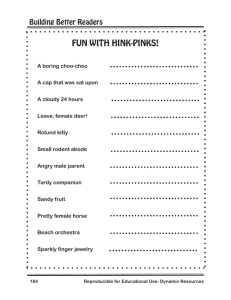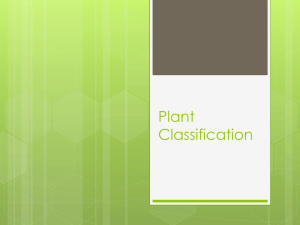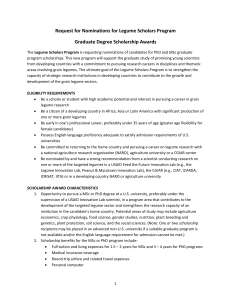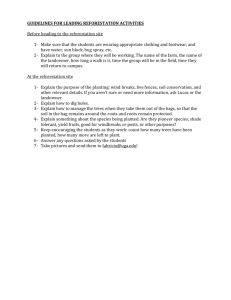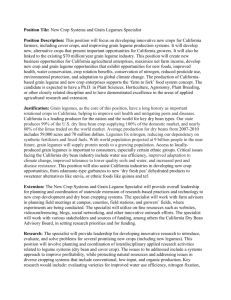Legume Choice tool overview 150615
advertisement
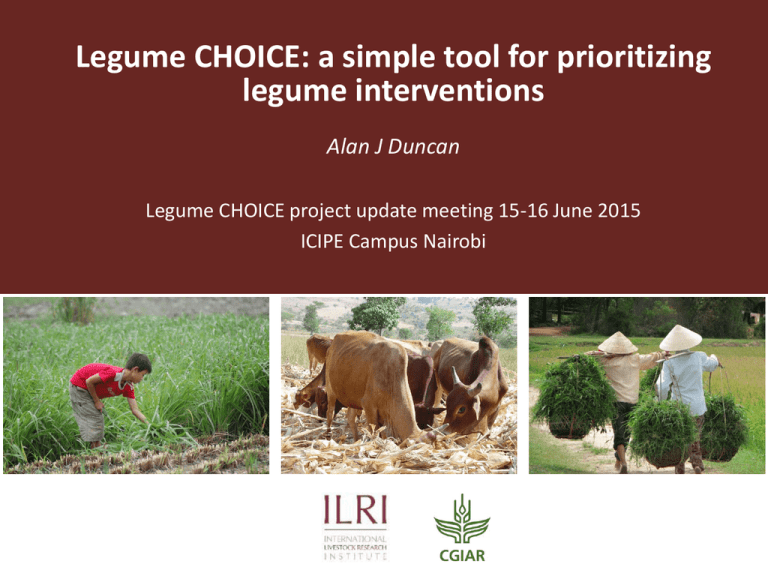
Legume CHOICE: a simple tool for prioritizing legume interventions Alan J Duncan Legume CHOICE project update meeting 15-16 June 2015 ICIPE Campus Nairobi Why do we need the Legume CHOICE tool? Conventional approaches to legume R4D focus focus on: Promotion Technology transfer Science driven Do conventional approaches meet the needs of beneficiaries? Food, feed, NRM? Dealing with farmer constraints Logical flow of Legume CHOICE tool components Qualitative diagnosis Qualitative assessment of farming context Intervention strategy Context assessment Community needs assessment Quantitative assessment of constraints Quantitative assessment of needs for functions Legume option attributes Legume types Type Grain legume Sub-type Seasonal Perennial Herbaceous legume Seasonal/no-regrowth (harvest after one season, then need reseeding) Examples Common bean (Phaseolus vulgaris Faba bean (Vicia faba) Soybean (Glycine max) Pigeon pea (Cajanus cajan) Velvet bean (Mucuna pruriens) Desmodium ???? Perennial/regrowth (ability to regrowth after seasonal harvesting) Tree legumes Not-coppicing after repeated cuts Coppicing after repeated cuts Calliandra (Calliandra calothyrsus) Albizia Glircidia Leucaeuna lecosephala Sesbania sesban Tephrosia (Tephrosia vogelii) Legume Functions Functions Food Livestock feed Income Erosion control Soil fertility Fuel Staking (e.g. for beans) Moisture retention Shading Beekeeping Fence/field boundaries Poles (e.g. construction) Biological control (push-pull) Pest and weed control Wind breaking Medicinal properties Carbon sequestration Biodiversity Primary Function X X X X X X Secondary Function Services X X X X X X X X X X X X Four core elements of the tool Qualitative Diagnosis Context Assessment Community Needs Assessment Legume Option Attributes Qualitative diagnosis • Aims – To brainstorm and identify constraints for legume intensification, i.e. increased productivity and area of existing legume species – To scope for niches for ‘new’ usage of legumes and introduction/adoption of ‘new’ legume types (species/varieties, for new uses; fodder, fuels, etc.) Process – focus group discussion • Question guide: • • • • • • What do we mean by “legume”? What benefits do legumes bring? Legumes/legume systems and their use Legume productivity, what are the limiting factors? Area used for legume production – what are the limiting factors? Niches and opportunities Four core elements of the tool Qualitative Diagnosis Context Assessment Community Needs Assessment Legume Option Attributes Context Assessment Methodology • Series of questions designed to generate scores for the following: • • • • • • • Land Labour Seed Inputs and services Knowledge Water Markets Four core elements of the tool Qualitative Diagnosis Context Assessment Community Needs Assessment Legume Option Attributes Community Needs Assessment Methodology • Designed to understand what the community wants from legumes: • • • • • • Food? Feed? Income? Erosion control? Fuel? Soil fertility? • Elements • • • Vision mapping Pairwise ranking Participatory matrix scoring Pairwise ranking exercise Four core elements of the tool Qualitative Diagnosis Context Assessment Community Needs Assessment Legume Option Attributes Legume Option attributes • A list of legume options scored for: • • Functions supplied – food, feed, erosion control etc Requirements – land, labour, inputs etc FunctionsContext – what–the what the community needs context supplies Legume options What these options What these options supply require Legume CHOICE report • Introduction • Farmer selection process and farmer list by typology • Qualitative Diagnosis results and reflections • Context assessment results and reflections • Vision Mapping results • Community needs assessment results • Legume Options Results • Preliminary ideas for top 3 legume interventions with justification drawing from Legume CHOICE results better lives through livestock ilri.org The presentation has a Creative Commons licence. You are free to re-use or distribute this work, provided credit is given to ILRI.
